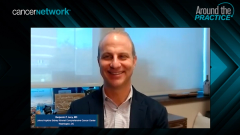
Patient Profile 2: EGFR Exon 19 Deletion–Positive NSCLC
Shared insight on the diagnosis and management of EGFR exon 19 deletion–positive NSCLC, with regard for the potential of osimertinib in this setting.
Episodes in this series

Transcript:
Charu Aggarwal, MD, MPH: We’ll move on to our second case that tackles a similar presentation. Let me lead us through this case in the setting of a biomarker. A 70-year-old Asian man presents to his primary care doctor and reports fatigue, headaches, and shortness of breath during daily walks over the last 2 months. [His]…medical history is significant for hypertension, which is very well controlled with medication. Physical examination is significant for decreased breath sounds on the left lower lobe of the lung. Lab data are normal. Imaging is performed with a CAT scan of the chest, abdomen, and pelvis that demonstrates a 4.5-cm mass in the left lower lobe. There are 2 enlarged lymph nodes in the mediastinum. A CT-guided transthoracic needle biopsy of the lung shows an adenocarcinoma consistent with a lung primary [tumor]. Molecular testing is performed [and] EGFR exon 19 deletion is found. The patient has not had formal mediastinal staging, but the clinical staging so far is a T2aN0M0 with an ECOG performance status of 1. In the setting of an EGFR exon 19 deletion, what is your initial impression of this patient? Would you proceed with surgery? I guess I’ll start with Harvey first. Maybe you would be more likely to see this patient in the clinic first. How would you manage this situation?
Harvey I. Pass, MD: Absolutely. This stages the mediastinum, and depending upon what I found in the mediastinum, the question is with the EGFR mutation, what are you going to do? I guess…if you found that you had stage 3a disease, I’m not so sure that you would be leaning toward giving immunotherapy since you’ve got an EGFR mutation. But certainly, you may want to think about induction chemo, which we’ve done before with or without radiation depending upon who’s arguing at the multidisciplinary clinic. And so it goes backward to the old days for me, but certainly it shows me the importance of staging. If you find that the lymph nodes are absolutely negative then sure, with the anticipation that you may still have a stage 2 or stage 3, you could operate on the patient and completely resect the patient. Then they would be a wonderful candidate for OC. So from my standpoint, a complete mediastinum staging by our interventional pulmonologist would [be done] and then [we would] go from there.
Charu Aggarwal, MD, MPH: I completely agree. And Ben, do you want to talk to us about the indications for adjuvant osimertinib or simultaneous [treatment] and where that data come from? Maybe talk about the ADAURA trial [NCT02511106]?
Benjamin P. Levy, MD: Sure. We’ve come to know osimertinib quite well in the advanced stage setting from the FLAURA data [NCT02296125]that showed a survival advantage with osimertinib versus the first-generation TKI [tyrosine kinase inhibitor] of advanced-stage disease. Now, osimertinib is a third-generation TKI and, of course, binds irreversibly to the intracellular domain of the tyrosine kinase. That’s being constitutively activated by a mutation in either exon 19, 21, or T790M, which can also be one target for osimertinib. We fast forward now whether we leverage osimertinib in the curative stage setting or in the adjuvant setting. We’ve now learned from a plenary session at ASCO [American Society of Clinical Oncology], followed by a New England Journal of Medicine paper, about the ADAURA trial, which was a pretty straightforward study that looked at patients with stage b through 3a resected lung cancer. All had an exon 19 or L858R and exon 21. Patients were resected and given adjuvant chemotherapy. We’ll talk about this per the discretion of the physician and then randomize 1:1 to osimertinib versus placebo.
Asking…does adjuvant osimertinib add anything to patients that [have] resected EGFR mutant lung cancer after [they’ve been] given chemotherapy per the discretion of the physician––again, there were roughly 700 patients. It’s a very large study and we saw hazard ratios that we don’t normally see for the patients. We’ll talk about end points but the primary end point was disease-free survival [DFS], not overall survival [OS], and this may be a sticking point; so we haven’t seen OS yet. We have early snapshots of OS but the hazard ratio was at least in the stage 2, 3a population; the hazard for DFS for adjuvant osimertinib was around 0.15, 0.17, which is incredible. These curves diverged very early on. If we look at the overall population, stage 1b to 3a, the hazard ratio is still very low [at] 0.21, [which is] statistically significant. If we look at the subsets and the forest plot, this goes back to a question that Harvey was asking. Only about 60% of patients got adjuvant chemotherapy in this trial. It was delivered prior to the discretion of the physicians but if you look at the DFS hazard ratio for those who got adjacent chemotherapy, it was around 0.18. If you looked at patients who didn’t get adjuvant chemotherapy, there was still a benefit at 0.23. So because of this, I think we look at…stage 1b, stage 2, and stage 3. If we divided it up by stage, obviously the higher the stage––this makes more sense––the lower the hazard ratio was for DFS. So for resected stage 1b, the hazard ratio is 0.5, [and for] resected stage 2, 0.17. You go to resected stage 3a, the hazard ratio comes down to 0.12. So the higher the stage, the more likely you were to benefit.
We haven’t seen OS here yet. We’ve seen early snapshots and this is a sticking point to the study that [will cause] many people to say, well, if we’re not curing patients [or] we don’t know if we’re curing patients, should we be leveraging this drug given it’s tossed in a potential toxicity? We have seen early snapshots also of CNS [central nervous system] relapse showing that the delivery of adjuvant osimertinib decreases the rate of CNS relapse versus placebo. And again, very early on was showing a significant reduction in CNS recurrence post surgery. So I think there’s pros and cons to this trial. There’s obviously the high rate of relapse that we see in the adjuvant setting. There’s a huge DFS advantage. This drug is well known to us. It’s one we’re familiar with and we’ve now got some observations on protection of the CNS because there’s no OS demonstrated yet. There were a group of patients obviously that didn’t get adjuvant chemotherapy. I’m not fluent in cost-effective analysis but there’s certainly a cost. I will say despite those cons, this has become a standard for me in my practice, and this underscores the importance of molecular testing in early-stage disease. I think this is one of the more significant studies we’ve seen. It’s been a game-changer for me and one that, again, I think we all adopt now with testing early stage so that we can deliver osimertinib for our patients with resected EGFR-mutant lung cancer.
Charu Aggarwal, MD, MPH: Ben, that was a great summary. I think one of the key takeaways from the study for me is that in the absence of an OS advantage for those patients that didn’t receive chemotherapy, we can’t really skip adjuvant chemotherapy and assume that we will get an advantage with the delivery of osimertinib.
Transcript edited for clarity.
Newsletter
Stay up to date on recent advances in the multidisciplinary approach to cancer.























































































